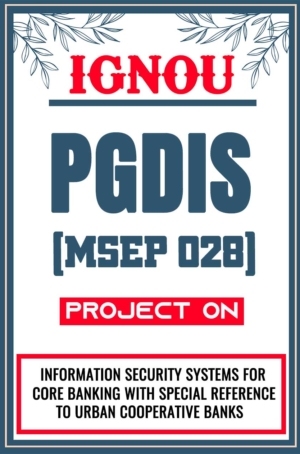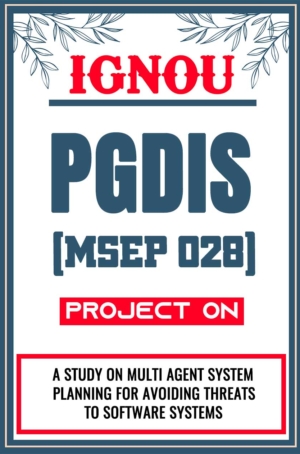Download IGNOU PGDIS Project (MSEP 28)
The IGNOU PGDIS Project Synopsis aims to provide a high-quality information security solution. The main purpose of the IGNOU PGDIS Project Synopsis assignment is to understand and acquire the principles of information security processes so that you may participate in and manage large IT projects in the future. The purpose of providing you with IGNOU PGDIS Project Work is to expose you to real-life situations while you are taking professional training in a variety of fields related to information security. The IGNOU PGDIS Project work trains students to work as information security officers, data recovery analysts, cybercrime inspectors, and security managers in any industry using information technology.
Whatsapp us to get the Personalized (Customized) or Readymade IGNOU PGDIS Project Report or PGDIS Synopsis
IGNOU PGDIS Project Topics (MSEP 28)
- A Study of Development of an Information Security Policy Framework for Organizations of India
- A Study Of Risk Management In Information Security
- Design And Analysis Of Security Architectures For Software Defined Radio
- A Study Of Proactive Threat Management For securing Software Systems
- A Study Based On Smart Bluetooth With Augmented Range And Security
- An Analytical Study on Technologies For Biometric Security System
- A Study Of Recent Trends In Securing Software Systems
- A Descriptive Study of Internet Users Doing Electronic Business With Special Reference To Security Threats On Electronic Business
What is the primary objective of the IGNOU PGDIS Project (MSEP 28)?
The primary objective of the MSEP 28 project is two-fold:
- Apply information security concepts to solve practical problems: This means taking the theoretical knowledge and skills you learned in the PGDIS program and using them to address real-world information security challenges. This could involve designing a security solution for an organization, analyzing a security breach, or developing a new security protocol.
- Demonstrate research, analytical, and presentation skills: The project isn’t just about applying knowledge; it’s also about showcasing your ability to conduct independent research, analyze data effectively, and present your findings in a clear and concise manner. This involves critical thinking, problem-solving, and strong communication skills.
How long does the IGNOU PGDIS Project (MSEP 28) take to complete?
There isn’t a strict timeframe officially mandated by IGNOU for completing the MSEP 28 project. However, there are general guidelines and factors to consider:
- Minimum and Maximum Program Duration: The entire PGDIS program, which includes the project, can be completed in a minimum of one year and a maximum of three years [IGNOU Synopsis source].
- Credit System: IGNOU uses a credit system, where each credit represents 30 hours of study time [IGNOU Synopsis source]. The MSEP 28 project itself might not be assigned a specific credit value, but this system provides a benchmark for the effort involved.
- Project Complexity: The complexity of your chosen topic and the depth of research will significantly impact the time required. A straightforward research project might take less time than a project involving practical implementation and testing.
- Individual Work Style: Some students work more efficiently than others. Consider your own research and writing pace when estimating the project duration.
Here’s a realistic range:
Based on these factors, expect to dedicate anywhere from 6 months to 1 year to complete the MSEP 28 project. This timeframe allows for thorough research, project development (if applicable), report writing, and revisions.
Are there any specific guidelines for documenting the IGNOU PGDIS Project (MSEP 28)?
Yes, IGNOU does have specific guidelines for documenting the MSEP 28 project. While the official guidelines might be available on the IGNOU website [IGNOU website], here a general outline of the structure you should follow:
Preliminary Pages:
- Title Page: Include the project title, your name, program details (PG Diploma in Information Security), enrollment number, and submission date.
- Certificate of Originality: A signed declaration stating that the project is your original work.
- Acknowledgement (Optional): Acknowledge the support and guidance received from your supervisor, mentors, or any other individuals who contributed to your project.
- Table of Contents: List all chapters, sections, and sub-sections with their corresponding page numbers.
Main Content:
- Introduction: Briefly introduce the project topic, highlighting its significance in the information security domain. State the research objectives or the problem you aim to address.
- Literature Review: Provide a comprehensive review of existing literature relevant to your project topic. This demonstrates your understanding of the current research landscape and identifies knowledge gaps you aim to address.
- Methodology: Explain the research methods you employed to gather data and analyze information. This could involve surveys, interviews, case studies, vulnerability assessments, or security protocol testing (depending on your project type).
- Project Implementation (if applicable): For projects involving practical implementation, detail the steps taken to develop the security solution or implement the security measures. Include diagrams, flowcharts, or screenshots (if relevant) to illustrate the process.
- Evaluation and Analysis: Present the findings from your research or project implementation. Analyze the data, interpret the results, and discuss their implications for information security.
- Discussion: Discuss the limitations of your project, potential sources of error, and alternative approaches that could be considered.
- Conclusion and Recommendations: Summarize the key findings and their significance. Offer recommendations based on your research or project outcomes.
- Future Scope: Briefly discuss potential areas for further research or development related to your project topic.
Ending Pages:
- Bibliography: List all the references you cited in your project report using a standard referencing style (e.g., APA, MLA).
- Appendices (Optional): Include any supplementary materials that support your project, such as questionnaires, data tables, or code snippets.
Formatting:
- Use a consistent font style and size throughout the report.
- Include page numbers.
- Maintain proper spacing and margins.
- Use headings and subheadings to structure the content effectively.
How should you prepare for the viva voce?
Here are some tips on how to prepare for the viva voce examination of your IGNOU PGDIS Project (MSEP 28):
Deep Understanding of Your Project:
- Thorough Knowledge: Ensure you have a comprehensive grasp of your project topic, including the research objectives, methodology, findings, and conclusions. Be prepared to discuss the rationale behind your chosen approach, limitations of the study, and potential areas for future research.
- Anticipate Questions: Think about potential questions the examiners might ask related to your project. These could delve deeper into specific aspects of your research, challenge your assumptions, or explore alternative viewpoints. Prepare concise and well-articulated answers that showcase your in-depth understanding.
Practice and Presentation:
- Rehearse Your Presentation: Prepare a short (~10 minutes) presentation summarizing your project’s key points. Practice delivering this presentation out loud, either alone or in front of a friend or family member. This helps refine your communication skills, identify areas for improvement, and boost your confidence.
- Visual Aids (Optional): Consider using visuals like flowcharts, diagrams, or graphs to enhance your presentation and explain complex concepts more effectively.
General Preparation:
- Project Report Review: Revisit your project report thoroughly. Refresh your memory on the details you might not have readily available and ensure you can explain any specific sections or methodologies used.
- Information Security Knowledge: While the viva voce focuses on your project, it’s also an opportunity to showcase your broader knowledge of information security principles. Be prepared to answer general questions about information security best practices, emerging threats, and relevant industry standards.
- Confidence and Clarity: Project your confidence during the viva voce. Speak clearly and concisely, avoiding jargon or technical terms that the examiners might not understand. If you’re unsure about an answer, politely state that you need more time to think or rephrase the question for clarification.
What if your IGNOU PGDIS Project Proposal (MSEP 28) gets rejected?
Don’t be discouraged if your IGNOU PGDIS project proposal (MSEP 28) gets rejected. It happens to many students. Here’s how you can approach the situation:
Understanding the Reasons:
- Request Feedback: Reach out to the program coordinator or your supervisor to understand the specific reasons behind the rejection. This feedback is crucial for revising your proposal effectively.
- Common Issues: Common reasons for rejection include:
- Topic Selection: The topic might be too broad, too narrow, or not relevant to the information security field.
- Clarity and Structure: The proposal might lack clarity in objectives, methodology, or overall structure.
- Feasibility: The project might be too complex to complete within the timeframe or lack access to necessary resources.
- Originality: The proposal might not demonstrate sufficient originality or build upon existing research.
Revision and Resubmission:
- Address the Feedback: Carefully analyze the feedback received and revise your proposal accordingly. Ensure your topic is clear, focused, and feasible within the given timeframe.
- Improve Structure and Clarity: Refine your proposal’s structure, ensuring a logical flow and clear presentation of objectives, methodology, and expected outcomes.
- Strengthen Originality: Demonstrate how your project builds upon existing research and offers a unique contribution to the information security field.
- Seek Guidance: Consult your supervisor throughout the revision process. They can provide valuable insights and ensure your revised proposal aligns with IGNOU’s expectations.
Alternative Options:
- New Topic: If the feedback suggests a significant overhaul is needed, consider exploring a new project topic that aligns better with the program’s objectives and your interests.
- Time Extension (if applicable): In some cases, you might be able to request a time extension for project completion, especially if the complexity of the original proposal necessitates more time.
How extensive should your literature review be?
There isn’t a strict page limit for the literature review section of your IGNOU PGDIS Project (MSEP 28). However, it’s crucial to strike a balance between comprehensiveness and conciseness. Here are some key factors to consider:
Depth vs. Breadth:
- Depth: Your literature review should delve deep enough into relevant sources to establish a strong foundation for your research. This means critically analyzing existing studies, methodologies, and findings related to your project topic.
- Breadth: The review shouldn’t simply list every source you find. Instead, it should demonstrate a well-rounded understanding of the current research landscape by covering key scholarly articles, books, and credible online resources.
Project Focus:
- Tailored Selection: The extent of the literature review should be proportionate to your project’s scope and complexity. A broader topic might necessitate a more extensive review, while a narrower, well-defined topic might require a more focused analysis of a smaller set of sources.
Quality over Quantity:
- Focus on Credibility: Prioritize high-quality, peer-reviewed academic journals, reputable conferences, and authoritative books within the information security field.
- Cite Relevant Sources: Select sources directly related to your research question or methodology. Avoid irrelevant or outdated information.
Here’s a general guideline:
While there’s no set page limit, a good rule of thumb is to aim for a literature review that spans 5-10 pages. This range allows you to provide a comprehensive overview of existing research without overwhelming the reader with excessive detail.
Get your IGNOU PGDIS Project Synopsis & Report Sample PDF
- Call us or WhatsApp us at: 9958947060, 9354637830
- Visit: SHRICHAKRADHAR.COM
-
Sale!

-
Sale!

IGNOU PGDIS Project (MSEP 28) Synopsis/Proposal & Project Report/Dissertation in Soft-Copy (Sample-2)
Original price was: ₹499.00.₹149.00Current price is: ₹149.00. -
Sale!

IGNOU PGDIS Project (MSEP 28) Synopsis/Proposal & Project Report/Dissertation in Soft-Copy (Sample-3)
Original price was: ₹499.00.₹149.00Current price is: ₹149.00. -
Sale!

IGNOU PGDIS Project (MSEP 28) Synopsis/Proposal & Project Report/Dissertation in Soft-Copy (Sample-4)
Original price was: ₹499.00.₹149.00Current price is: ₹149.00. -
Sale!

IGNOU PGDIS Project (MSEP 28) Synopsis/Proposal & Project Report/Dissertation in Soft-Copy (Sample-5)
Original price was: ₹499.00.₹149.00Current price is: ₹149.00. -
Sale!

IGNOU PGDIS Project (MSEP 28) Synopsis/Proposal & Project Report/Dissertation in Soft-Copy (Sample-6)
Original price was: ₹499.00.₹149.00Current price is: ₹149.00. -
Sale!

IGNOU PGDIS Project (MSEP 28) Synopsis/Proposal & Project Report/Dissertation in Soft-Copy (Sample-7)
Original price was: ₹499.00.₹149.00Current price is: ₹149.00.
